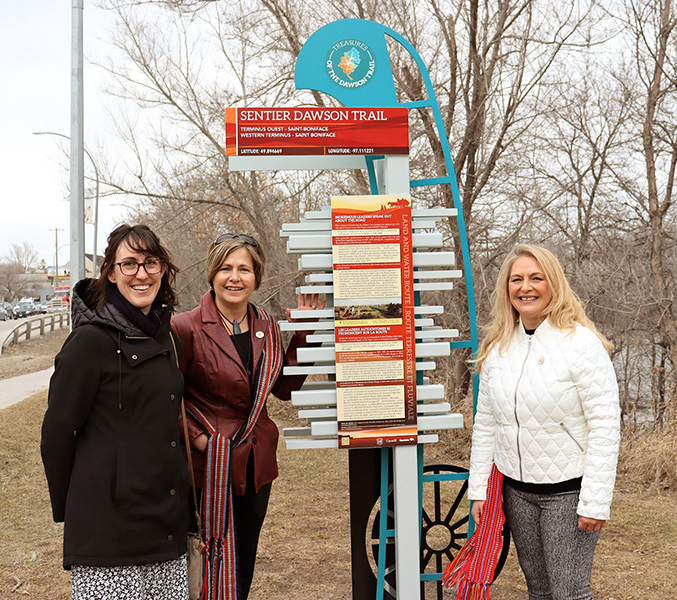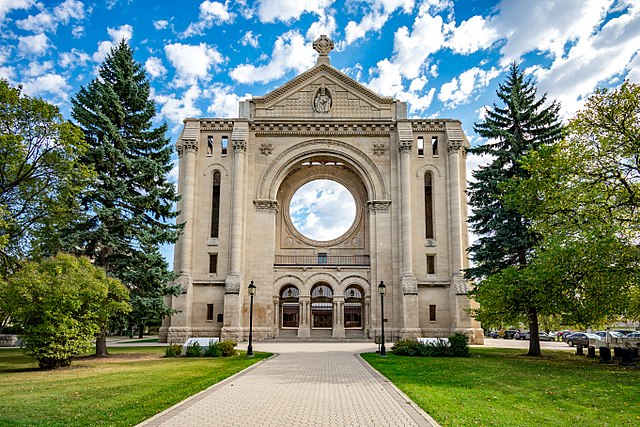If you are starting your driving tour from within the City of Winnipeg, you can stop and see St. Boniface which is rich in historical significance on the way to Prairie Grove. However if you are starting from outside the Perimeter / Floodway then proceed to Prairie Grove as your first Tour location.
Commemorative Marker #15 - Western Terminus
SEE GOOGLE MAP LOCATION 
Theme: Western Terminus of the Dawson Trail / The Canadian Pacific Railroad's "Grand Trunk embankment" / Red River Crossing / Indigenous leaders speak about the road
The final interpretive marker on the western terminus of the trail is located on Provencher Boulevard at the Seine River Parkway.

While the story of the Dawson Trail has been explored by many over the years, you will find none quite as diverse as the one that we have compiled here for you all to enjoy.
Months of research from literally thousands of sources have provided us with fresh insights into this age-old story. As a road that has been recognized for its historical and cultural significance at all three levels of government, we hope you’ll agree that the Dawson Trail is a story worth exploring and sharing anew.
We reach beyond colonial narratives on its role in linking together a new nation to bring you some lesser-known “nuggets” about the coming of the road, and its impact, that foregrounds community knowledge as well as Indigenous and women’s experiences. These more diverse perspectives highlight the need to bring this story into the era of national reconciliation with Indigenous peoples.
HISTORICAL NUGGETS CONNECTED WITH THIS LOCATION:
The Sale of Rupertsland | Simon J. Dawson: Surveyor, Civil Engineer & Politician
Anishinaabe Chief Showed Dawson the Way | Lumber for the “Mother Church of Western Canada”
St. Boniface
Succeeding cultures of indigenous peoples lived in the area for thousands of years before European exploration. It was an area of historic Ojibwe occupation.

Postcard image showing St. Boniface Ferry Crossing approximately 1909. Source: Peel Library, University of Alberta http://peel.library.ualberta.ca/postcards/PC002387.html
Fur traders and European mercenaries hired by Lord Selkirk to protect his fledgling Red River Colony were among the area's first European settlers. With the founding of a Roman Catholic mission in 1818, St Boniface began its role in Canadian religious, political and cultural history – as mother parish for many French settlements in Western Canada; as the birthplace of Louis Riel and fellow Métis who struggled to obtain favourable terms for Manitoba's entry into Confederation; and as a focus of resistance to controversial 1890 legislation to alter Manitoba's school system and abolish French as an official language in the province (see Manitoba Schools Question).
French-speaking religious orders, including the Sisters of Charity of Montreal (better known as the Grey Nuns), who arrived in 1844, founded the early educational, cultural and social-service institutions, such as St. Boniface Hospital, the first in Western Canada. Early French-speaking missionary Catholic priests in the region founded the Collège de Saint-Boniface (dating to 1818) to teach Latin and general humanities to the local boys; it is now the Université de Saint-Boniface.
St Boniface was incorporated as a town in 1883 and as a city in 1908.
Source: Taken from https://en.wikipedia.org/wiki/Saint_Boniface,_Winnipeg
Other points of interest in St. Boniface include:
![]() Whittier Park / Fort Gibraltar
Whittier Park / Fort Gibraltar
![]() Le Musée de Saint-Boniface Museum
Le Musée de Saint-Boniface Museum

St. Boniface Cathedrale today. On July 22, 1968, the 1906 cathedral was damaged by a fire which destroyed many of the structure's features and contents including the rose window, vestments, 1860 bells, and parish records. Only the façade, sacristy, and the walls of the old church remained. In 1972, a new, smaller cathedral, designed by Étienne Gaboury and Denis Lussier, was built behind the 1906 façade.

Whittier Park - Fort Gibraltar was founded in 1809 by Alexander Macdonell of Greenfield of the North West Company in present-day Manitoba, Canada. It was located at the confluence of the Red and Assiniboine rivers in or near the area now known as The Forks in the city of Winnipeg. Fort Gibraltar was renamed Fort Garry after the merger of North West Company and the Hudson's Bay Company in 1821, and became Upper Fort Garry in 1835.
Go to Next Tour Location: Lagimodiere Blvd. Marker #14 | Top
Previous page: Dawson Trail Heritage Tour
Next page: Lagimodière Boulevard
